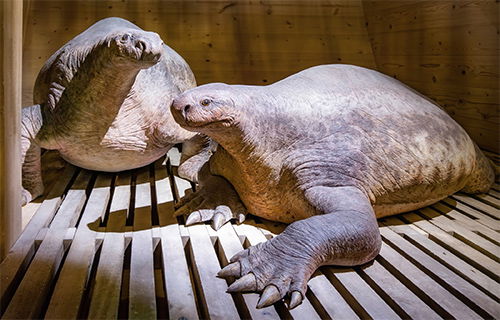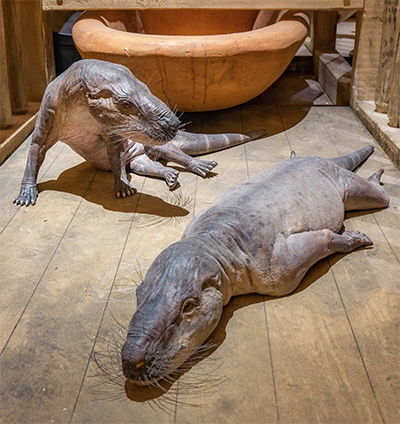
All Aboard—Unexpected Passengers on Noah’s Ark
Imagine what it was like for Noah and his family as they looked down row upon row of enclosures after the last animals had arrived from around the world and were safely stored in their three-level, floating “warehouse.” The rafters must have shaken with the squawking, barking, and hooting of so many animals. A mixture of excitement, fear, and wonder surely filled the hearts of Noah’s family.
Ask the typical churchgoer to identify which creatures were there, and out of their mouths would pour a list of common zoo and barnyard fare found in children’s stories: elephants, kangaroos, lions, bears, cows, and sheep. But history often looks much different than we imagine based on our limited perspective. Sometimes reality is far more interesting than our imagination.
When we consider fossils and extinct creatures, the ark surely contained many animals we would not normally consider. Meanwhile, other amazing species that we just know were there probably weren’t.
Formerly a zookeeper at Answers in Genesis’ Creation Museum, I was transferred a few years back to work with scientists to help develop a who’s who of animals on board the full-size Ark Encounter, located in Kentucky. I already knew a few popular misconceptions about the animals on Noah’s ark, such as the common belief that no dinosaurs were aboard, but many other big—and little—surprises awaited me.
By studying the diversity of animals on Noah’s ship, we can understand how many creatures were destroyed in the flood and how so few animals repopulated the earth with the variety we enjoy today.
Why Aren’t Giraffes on the Ark?
Visitors to the Ark Encounter are often surprised by the animals that are “missing.” At the top of many lists is one of the great icons of Noah’s ark: long-necked giraffes.
Go ahead and look around. Walk the ship from bow to stern, port to starboard, bottom deck to the top. Nowhere will you see a pair of classic giraffes towering above your head.

Shansitherium
Fossils of this short-necked member of the giraffe family were discovered in early post-flood Miocene layers of Shanxi Province, China.
What you will find, housed in a large enclosure on the middle deck, are some spotted creatures, perhaps around your height, with relatively short necks and stocky bodies. These odd-looking beasts look strikingly like Shansitherium, a creature you’d find in a few natural history museums. Yet the sign indicates that these are the Ark Encounter’s representatives of the giraffe kind. How could this be?
You may find it surprising, but long-necked giraffes aren’t the only living members of the giraffe family. Can you guess the identity of the other one? It lives in the forests of central Africa. Though sometimes mistaken for a horse because of its size, shape, and zebra stripes, the short-necked okapi is closely related to giraffes. Aside from the markings and body proportions, the differences between giraffes and okapis are relatively minor. Because of the similarities of these two animals, biologists place them in the same family classification, Giraffidae. Modern biblical creationists would agree that these similarities put them in the same created kind.
So why depict the giraffes on the ark as more like okapis? After all, only one species today has a short neck, but four or more species are long-necked. Several other long-necked species have been discovered in the fossil record. Doesn’t it make more sense to depict the giraffes on the ark as long-necked?
That is where Shansitherium comes in. The most reasonable way to settle the issue is to look at the earliest post-flood fossils of giraffes and see what sorts of necks they had. The expectation is that the earliest descendants of the ark’s inhabitants looked more like the originals than their highly specialized modern descendants. By comparing the neck bones of giraffe fossils and charting them according to their relative geologic layers, two things become apparent.
First, only one recent branch of the giraffe family tree—a minority of known giraffids—possesses the long, slender necks. Second, the earliest fossils of giraffes (located in the lower post-flood geologic layers) are always more okapi-like, with shorter necks. The giraffids at the Ark Encounter are based on an early fossil variety from China called Shansitherium (sometimes spelled Schansitherium).
Not only do they feature short necks, if you check out the tops of their noggins, you’ll see some unusual headgear. Those skin-covered knobs are called ossicones. Modern giraffes and okapis have simple, unbranched knobs. But several extinct giraffids had branched ossicones—some of which even resembled elaborate moose antlers! The knobs on Shansitherium were branched into four points. We see that God placed within the giraffe kind a broad spectrum of forms that were expressed throughout post-flood history.
So if someone wonders why there aren’t any giraffes on the ark, you can tell them that in a sense there are: the same way you and I are represented there by Noah’s family.
What Are “Walking Whales” Doing on the Ark?
The Ark Encounter will introduce you to some animals you may not expect to see at a creationist attraction. We include several animals that are featured prominently as “transitional forms” in evolutionary textbooks and natural history museums. That includes so-called “walking whales.”

Pakicetus
Somewhat resembling a dog, this alleged whale ancestor was a semiaquatic mammal excavated from early post-flood Eocene layers in Pakistan.
We made these selections intentionally to imply that fossil evidence isn’t divided up like a deck of cards, with some evidence being dealt into the “evidence for evolution” pile while the rest goes into an “evidence for creation” pile. We all live in the same world with the same fossil evidence. So what sets the creation view apart from the evolutionary view is how we read the evidence within our interpretive framework. Creation and evolution reach different conclusions because they have different interpretative frameworks. In other words, they have different preconceptions or biases that shade how they view the same evidence.
One of these “surprising creatures” is an extinct mammal called Pakicetus. Fossil remains from related creatures have been known since 1958, but in 1979, the discovery of a partial Pakicetus skull, jaw fragment, and a few isolated teeth was used to popularize the idea that these creatures were early whales with legs that lived in the sea. But just how whalelike were they?
The earliest published depiction of a living Pakicetus was rather cartoonish. The artist gave it a fairly whalelike head attached to a vaguely otter-like body. Considering the limited fossil evidence, this portrayal of a sea creature is somewhat forgivable. But once nearly complete remains were found, opinions began to shift. One group of researchers initially swung in the opposite direction, saying Pakicetus was “no more amphibious than a tapir [a piglike creature that lives near water],” but it seems most experts now think it was a bit more aquatic.
Where are the bugs?
The Bible does not seem to indicate that insects and other arthropods were required on the ark. The animals that entered the ark were those “in which is the breath of life” (Genesis 7:15, NKJV). Several verses later the text explains that all of the land animals “in whose nostrils was the breath of the spirit of life . . . died” (Genesis 7:22, NKJV). Insects do not breathe through nostrils (they take air in through spiracles in their exoskeletons), and they could likely survive the flood on floating debris as eggs or in larval or pupal form. So it is doubful that insects were required to be on the ark, although perhaps the more delicate insects were on board, such as butterflies and moths.
The primary reason Pakicetus and similar animals are classified as “early whales” is that they had specialized bony structures in their ears, called auditory bullas, otherwise seen only in whales. The large, thick, rounded bones would have helped them hear underwater. Yet other features of their ears were more like typical land mammals. An average person on the street would never think they were whales simply by looking at them: they look more like dachshunds than dolphins!
However, it is worth noting that pakicetids did have other aquatic-friendly traits that a biologist would recognize. For instance, their eyes were positioned close together toward the tops of their heads, similar to crocodiles, and their leg bones were very dense, possibly acting as ballasts. All of these traits would have been assets for wading in shallow water.
So it does appear that pakicetids were somewhat aquatic, though less so than walruses and sea otters. But a big question remains: Is there compelling evidence to conclude that pakicetids were the ancestors of today’s whales and dolphins?
Creationists recognize that some creatures in the animal kingdom have interesting variations that have enabled them to live in very different environments. For instance, flightless dodos are considered members of the pigeon kind. This means that these land dwellers were descendants of the same kind of birds as Noah’s flying dove that brought him an olive leaf. Another interesting example is an extinct sloth (Thalassocnus) that was so aquatically adept that scientists believe it was primarily a marine creature.
This isn’t one kind of animal changing into a completely different kind of animal. After all, the sloths are still sloths and the doves are still doves. Instead, God gave certain kinds of animals the genetic variation necessary to adapt to specific environments just as they were designed to do.
Is it possible “early whales with legs” and modern whales are members of the same kind—a kind that eventually lost the ability to live on land? The vast majority of biblical creationists reject that notion because the variations seem so extreme. While there’s good fossil evidence connecting aquatic sloths and land sloths, or flightless doves with flying ones, there are notable gaps in the evidence that supposedly connects whales to “early whales” like Pakicetus.
The Ark Encounter embraces the existence of this unusual kind of creature that may have lived on land and spent much of its time in the water like the South American rodent capybara; however, we would not call them “early whales” or put them in the same “kind” category as modern whales.
So if anyone wonders what these “icons of evolution” are doing on Noah’s ark, you can tell them that, rather than evidence for evolution, we believe pakicetids were semiaquatic animals, unrelated to whales, and they further demonstrate the amazing creativity of our God.
What Sort of Creatures Are These?
The fossil record includes many fascinating creatures that are unfamiliar to us. Yet most of the time we can at least recognize the animal varieties by their classes, whether reptiles, mammals, amphibians, or birds. Even our previous examples, giraffids and pakicetids, are quickly recognizable as mammals. What about dinosaurs? In most cases, they are easy to distinguish too. But a few oddballs in the fossil record don’t fit any of these categories. The nonmammalian synapsids are a good example.

Cotylorhynchus
Fossils of this extinct nonmammalian synapsid were discovered in flood deposits of the Permian layers of Texas and Oklahoma.
Those are two curious words. Nonmammalian seems obvious, but what are synapsids? They are members of a higher animal category called Synapsida. Their defining characteristic, from which the name is derived, is a skull opening, called a temporal fenestra, behind each eye. (The bones around the opening form a “fused arch,” or synapsis.) They also have certain tooth and jaw traits, but no need to bore you with all the details.
Mammals have this opening and fused arch, too, but more important for us is the reason for designating some synapsids as nonmammalian. As you might expect, mammalian synapsids are simply known as mammals. You can think of mammals as a smaller container within the larger container of synapsids. Obviously lots of mammals are around today, but nonmammalian synapsids are presently known only from fossils excavated from flood rock layers.
One variety of nonmammalian synapsid might be familiar to you and is often confused with dinosaurs: Dimetrodon, a low-lying, sail-backed creature. But wait—why aren’t these animals grouped with reptiles? Well, despite their generally lizard-like appearance, the details of Dimetrodon anatomy are in many ways closer to mammals than living reptiles. The acknowledgement of these mammal-like qualities over their reptile-like traits has reduced the popularity of an older term for nonmammalian synapsids: mammal-like reptiles.
To see a prime example of just how mammal-like some of these creatures were, check out an Ark Encounter critter called Cynognathus. It could almost be confused with a medium-sized dog (though a bit deformed and nearly hairless). Unlike the sprawling, somewhat lizard-like synapsid Dimetrodon, Cynognathus held its arms in a more upright position, perhaps causing it to walk with an opossum-like gait. Its name means “dog jaw,” reflecting the very mammal-like design of its lower jaw and teeth.

Cynognathus
Found in Middle Triassic layers throughout the Southern Hemisphere, this extinct nonmammalian synapsid is uncovered only in flood deposits.
Since synapsids apparently form a broad spectrum of highly varied kinds, we might expect them to have possessed varying skin types, textures, and coverings. And indeed, it appears they did. Fossil remains indicate that their covering ranged from bony armor and scales to bare skin and probably some hair. The best evidence indicating the presence of hair comes from the pockmarked muzzles of Cynognathus specimens. Whisker-attached nerves and blood vessels were presumably threaded through these small holes. It is unknown if Cynognathus was largely covered in hair or more bare-skinned like the ones depicted at the Ark Encounter, but one thing is certain: They are fascinating creatures apparently quite unlike anything alive today.
Considering their peculiarities and their confusing classification, are synapsids transitional forms bridging the evolutionary gap between “typical” reptiles and mammals? That is the assumption of those who hold to evolutionary ideas, but what does the evidence actually point to? Before the flood, some animals that we might call “reptiles” today had features more like mammals than living reptiles. Some of the animal types that thrived before the flood are no longer alive today—kinds that do not fit neatly into the boxes we’ve established for modern animals. In other words, we’re finding that God was creative in many more ways than previously imagined. And that is a finding that biblical creationists would expect and should enthusiastically embrace.
The One Who Has Made Them
In the end, there are many things we’ll never understand about the ark animals—well, on this side of eternity anyway. But that’s okay. Searching out the treasures God has hidden for us in history is an honorable thing (see Proverbs 25:2).
As for me, my role in this hunt has been relatively small but filled with ever-increasing surprises. They constantly stretch and refresh my understanding of God’s marvelous works in the past, keeping me humble as I interpret the latest scientific findings within the framework of Scripture. I must always start with God’s Word and then interpret all of mankind’s incomplete discoveries within its light. May these marvels of creation continue to spark delight—and awe—in our hearts, as we worship the God who made them.

Ark Kinds by the Numbers
Calculating the number of animals on Noah’s ark is complex. The Bible says God sent 2 of some kinds and 14 of others. This chart summarizes the final count obtained by Answers in Genesis researchers and others who developed the animal exhibits at the Ark Encounter. See, the massive ark had plenty of room!Related Downloads
How Many Animals Were on the Ark? Chapter 9 (Master Books)
PDF DownloadAnswers Magazine
July–August 2019
When we consider fossils and extinct creatures, the ark surely contained many animals we would not normally consider. What animals were—and weren’t—on the ark?
Browse IssueRecommended Resources

Answers in Genesis is an apologetics ministry, dedicated to helping Christians defend their faith and proclaim the good news of Jesus Christ.
- Customer Service 800.778.3390
- Available Monday–Friday | 9 AM–5 PM ET
- © 2026 Answers in Genesis



